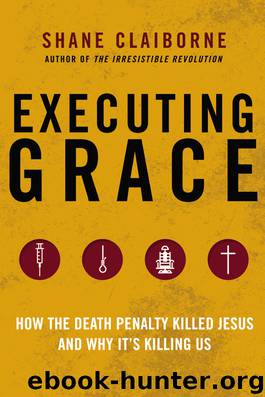Executing Grace by Shane Claiborne

Author:Shane Claiborne
Language: eng
Format: epub
Publisher: HarperCollins
Published: 2016-05-05T04:00:00+00:00
CHAPTER EIGHT
Race, the Death Penalty, and Lynching
The 13 states that comprised the Confederacy have carried out more than 75 percent of the nation’s executions over the last four decades.
—from the Connecticut Supreme Court treatise that declared the death penalty unconstitutional in 2015
One of the most powerful arguments against the death penalty is the simple fact of how disproportionately it is applied based on race. Even if you think the death penalty is just in theory, it is hard to support when we see how often its application is distorted in practice. And if we are going to talk about race and the death penalty, then we must also talk about the suppressed history of lynching in the United States.
It would be irresponsible to talk about the death penalty in the context of the United States and not mention lynching—especially since we’ve seen the powerful parallels between the lynching of black folks in America and Jesus as the first lynchee.1
Lynching is defined as the killing of a person, often by hanging, for an alleged offense, usually without a legal trial. It is what Bryan Stevenson, quoted in earlier chapters, has called “racialized terror.” Lynchings claimed the lives of thousands of men, women, and children in the United States, especially in the late 1800s and early 1900s.
I want to be careful not to equate lynchings with current-day executions. Not even the most ardent supporter of capital punishment is advocating the legitimacy of lynching. Still, the relationship between the death penalty and lynching is nonetheless eerie and haunting. Understanding what was behind lynchings can shed light on what is behind public support of the death penalty today. And what we see is that it has a lot to do with race.
It turns out that the decline of lynching relied heavily on the increased use of capital punishment. The roots of the death penalty are sunk deep in the legacy of lynching; as lynchings decreased, legal executions increased.
Of course, there is one key difference between lynching and capital punishment: capital punishment is administered by the state, whereas lynchings are “vigilante justice” (though in their U.S. heyday they were often underwritten tacitly or explicitly by police, judges, and other agents of the state). But despite that difference, the parallels between lynching and the death penalty are startling.
Eight in ten lynchings that occurred in the United States from 1889 to 1918 occurred in the South. Now (since 1976) eight in ten executions are in the South. In other words, the places that were most inclined to unofficial execution by lynching a hundred years ago are drawn to official execution today.2 It is fair to say, as Bryan Stevenson and the other esteemed lawyers of the Equal Justice Initiative assert, “Capital punishment remains rooted in racial terror—a direct descendent of lynching.”3
Eight in ten lynchings occurred in the South. Now eight in ten executions are in the South. The states that lynched are the ones that are still executing today.
Download
This site does not store any files on its server. We only index and link to content provided by other sites. Please contact the content providers to delete copyright contents if any and email us, we'll remove relevant links or contents immediately.
The Borden Murders by Sarah Miller(4022)
The Secret Barrister by The Secret Barrister(3425)
Coroner's Journal by Louis Cataldie(2361)
Police Exams Prep 2018-2019 by Kaplan Test Prep(2359)
The Splendid and the Vile by Erik Larson(2231)
Terrorist Cop by Mordecai Dzikansky & ROBERT SLATER(1965)
My Dark Places by James Ellroy(1806)
A Colony in a Nation by Chris Hayes(1797)
Black Klansman by Ron Stallworth(1705)
The Art of Flight by unknow(1697)
A Life of Crime by Harry Ognall(1596)
Objection! by Nancy Grace(1570)
The New Jim Crow by Michelle Alexander(1550)
Whoever Fights Monsters by Robert K. Ressler(1536)
Anatomy of Injustice by Raymond Bonner(1531)
Invisible Women by Caroline Criado Perez;(1521)
Obsession (The Volkov Mafia Series Book 1) by S.E Foster(1496)
American Prison by Shane Bauer(1481)
A is for Arsenic: The Poisons of Agatha Christie (Bloomsbury Sigma) by Kathryn Harkup(1457)
